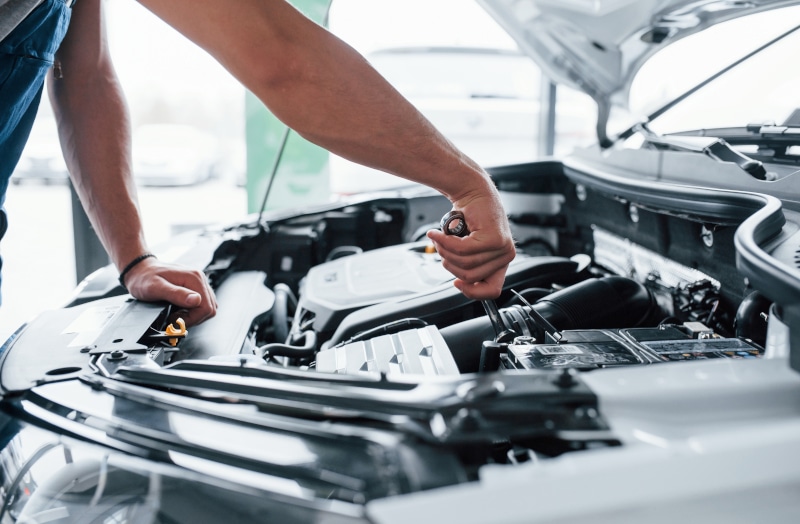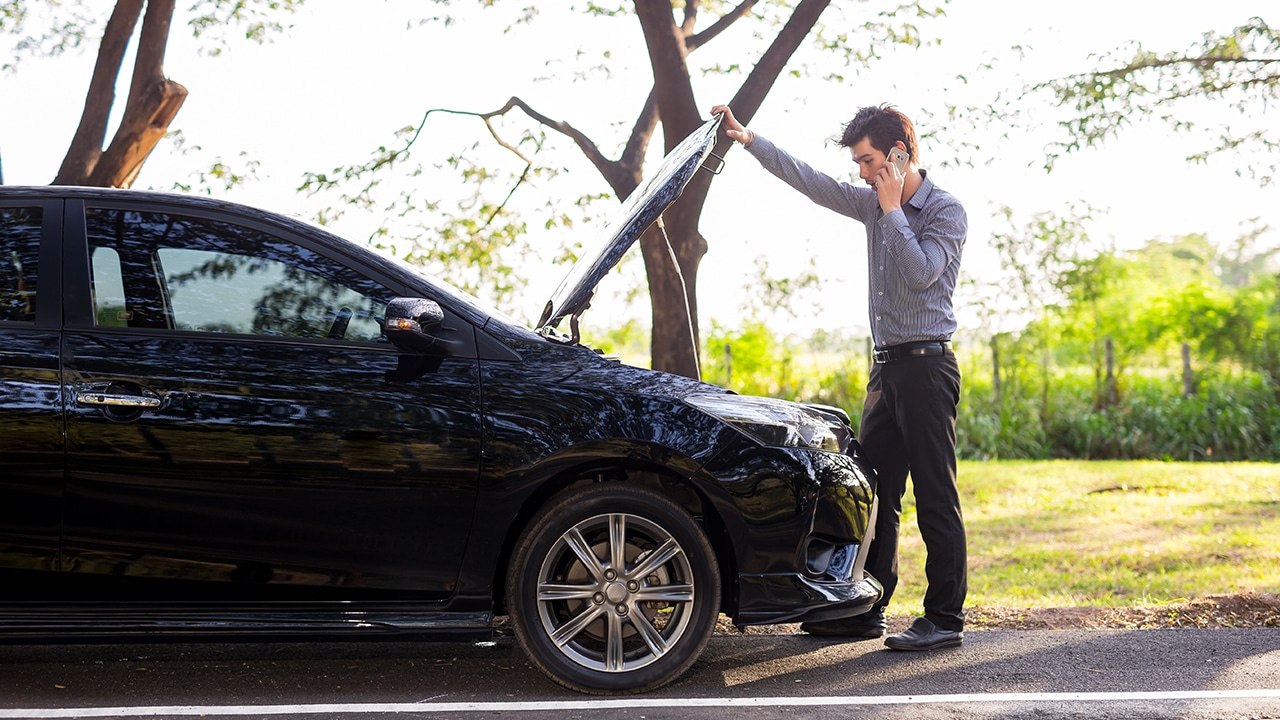CarShield, Discount ESP, Total Auto Protect, Pinnacle Protection Plans and Motorcycle Agent offer the best motorcycle extended warranty programs.
Car Warranty
Learn more about auto warranties with detailed research, rankings, and guides to protect your vehicle
You may have considered buying a car warranty, whether under pressure at the car dealership or out of your own interest. But what is a car warranty? And what — if any — advantages do they have for car owners?
We at the MarketWatch Guides team compiled our research to create this car warranty guide. In it, you’ll find a thorough breakdown of each kind of warranty, what it offers, where to buy a warranty, how much it costs and more.
What Is a Car Warranty?
A car warranty is a vehicle service contract (VSC) in which a provider agrees to pay for repairs to components and systems covered in the agreement. It covers defects and damage that affect vehicles during normal use but doesn’t cover standard wear and tear.
Types of Car Warranties
People and businesses use the term “warranty” to describe several types of products. While these products are similar, it’s important to understand their differences.
These are the common types of VSCs for personal automobiles:
- Factory warranty: A manufacturer’s new car warranty is a true warranty. They come packaged with most new vehicles and typically cover the majority of a vehicle’s components.
- Certified pre-owned (CPO) warranty: This warranty is like a new car factory warranty but comes packaged with used cars certified by the manufacturer. Plans vary, but CPO warranties tend to offer coverage similar to a new car warranty.
- Extended warranties: More accurately called VSCs, extended warranties cover your vehicle after your factory warranty or CPO warranty expires. These plans are sold by third-party providers, as well as car manufacturers themselves.
How a Manufacturer’s Car Warranty Works
Manufacturer warranties are coverage plans provided by the car’s manufacturer. Whether in the form of a new car factory warranty, CPO warranty or extended warranty, these plans cover the cost of repairs for specified components if needed.
When you get a car warranty from the manufacturer, you’ll get a list of components that are covered or not covered. If a covered component needs repair or replacement, the manufacturer pays most or all of the cost. Some manufacturer warranties come with a deductible, while others don’t.
Car Warranty vs. Recall
A car warranty and a recall are similar in that auto repair bills are typically covered under both. But that’s about where the similarities end.
A recall is when an automaker has been alerted to a manufacturing defect or other problem in certain vehicles and decides to roll out a large-scale replacement or repair program. If your vehicle falls under a recall, you can get the repair done for free at the expense of the manufacturer.
Car warranties also pay for replacement and repair costs. However, they do so on a case-by-case basis for individuals.
What Does a Car Warranty Cover?
You typically don’t have any choice over your car’s factory warranty, but if you decide to purchase extended warranty coverage, you may be able to choose from several options. The specific components and systems that a car warranty covers may vary, but most fall into one of a few categories and subcategories.
Exclusionary Car Warranty
An exclusionary car warranty, also referred to as a bumper-to-bumper warranty, covers the vast majority of a vehicle’s components and systems. They’re called “exclusionary” because the contracts have a short list of exclusions — or parts that aren’t covered — rather than a list of components that are covered.
Exclusionary coverage is typical with new car factory warranties and CPO warranties. You may be able to purchase an exclusionary extended warranty, but you’ll also have other options.
Inclusionary Car Warranty
An inclusionary warranty lists the components it does cover in the contract. Anything not specifically mentioned doesn’t fall under warranty protection.
Also known as “stated-component” warranties, these plans are more common with extended warranties. They also tend to come with multiple levels of coverage, depending on the provider.
Types of Inclusionary Warranties
Extended warranty plans and especially those from aftermarket providers usually have a few options for stated-component coverage. These are the most common subcategories:
- Comprehensive stated-component: This is the highest level of stated-component coverage. These plans typically come close to matching the coverage of an exclusionary warranty, but they have a few important distinctions.
- Medium stated-component: Medium-level coverage tends to cover higher-end systems like electrical components and air conditioning in addition to most engine- and drivetrain-related components.
- Powertrain plus: One step up from the most basic coverage, a powertrain plus warranty usually covers items like the fuel system and the basic drivetrain components.
- Powertrain: The most basic level of warranty coverage, a powertrain warranty covers the components that keep the car moving on the road, such as the engine, transmission, drive axles and other related parts.
Car Warranty Plans
Although coverage varies among manufacturers and third-party providers, most warranty plans offer relatively standardized coverage and fall into a few categories.
New Car Factory Warranty
- Limited or standard bumper-to-bumper: Most manufacturers offer some period during which the factory warranty covers nearly everything in the car. If you see two mileage or age limits mentioned, this is usually the shorter of the two.
- Powertrain: Many automakers include powertrain coverage that extends beyond the bumper-to-bumper factory warranty, often by several years or tens of thousands of miles.
- Emissions: New cars typically come with some kind of warranty on emissions components such as the catalytic converter.
- Corrosion: Automakers sometimes include protection against rust and corrosion on vehicle components and the car’s body.
- Extended factory limited: Some manufacturers include an option to extend factory coverage beyond the original terms.
- Other types of coverage: New cars often come with coverage specific to that vehicle or category of vehicle. For example, electric vehicles and hybrids may come with special protection for their batteries. Other examples are diesel engine coverage and safety restraint warranties.
CPO Warranty
- Limited or standard bumper-to-bumper: Some automakers include high-level exclusionary coverage with CPO vehicle warranties.
- Powertrain: Many CPO vehicles come with powertrain and drivetrain protection with terms that extend beyond the bumper-to-bumper coverage.
- Other types of coverage: Like with new car warranties, many CPO vehicles have included or optional coverage for components or systems specific to that type of vehicle.
Extended Warranty
- “Limited” or “standard” bumper-to-bumper: Exclusionary coverage is available from some extended warranty providers. However, most of these plans have restrictions on the age, type and condition of vehicles that are eligible for coverage.
- Stated-component: Many providers, especially third-party providers, offer a few levels of stated-component coverage for used vehicles. This allows owners to tailor their coverage to their budgets and needs.
- Powertrain: Basic coverage is typically available for most vehicles.
Coverage Add-ons
With many providers, you also have the option to purchase coverage for components that aren’t included with a car warranty. Here are some of the more common examples:
- Prepaid maintenance: You can purchase prepaid packages for routine maintenance services like oil changes, tire rotations and fluid services, often at a discounted rate.
- Trip interruption coverage: A trip interruption package covers some or all of expenses such as lodging and food if you need vehicle repairs while you’re far from home.
- Roadside assistance: Protection plans often cover the cost of emergency roadside services as a perk, depending on the provider. If they don’t, it’s usually available as an option.
- Rental car reimbursement: You can add rental car coverage that pays for some or all of the cost of renting a vehicle while your car is being repaired.
- Paint protection: These plans cover the cost of cosmetic damages to your car’s paint.
- Auto glass coverage: You can purchase protection for your car’s windows and windshield. These plans cover cracks, chips and nicks and may cover the cost of a full replacement.
- Tire coverage: Tire protection plans, usually bought from a service center or tire manufacturer, generally cover tire damage such as leaks, punctures and tears. Many also cover the cost of balancing and rotating your tires.
- Wear-and-tear packages: Some providers offer plans that cover replacement of basic wear-and-tear items such as brake pads.
How To Check if Your Car Is Under Warranty
If you’re considering purchasing a car warranty, first make sure you’re not already covered. This is a relatively simple process with a few options.
Here’s how to check:
- Find your vehicle identification number (VIN): You may not need your car’s VIN to check whether it’s under warranty, but it’s good information to have anyway. You can typically find the VIN in a few places, depending on your manufacturer. It could be at the bottom of the driver’s side of the dash, visible through the windshield. It could also be in the driver’s side doorjamb or near the front of the engine compartment.
- Check your mileage: Car warranties come with mileage limits. Check your odometer to see how many miles you have on your vehicle.
- Call a dealership: A dealership can help you get a certain answer on whether or not you’re covered under warranty. You’ll need to supply them with your VIN to allow them to look it up.
- Check online: It’s not hard to find mileage and age limits for warranties online. You should be able to find the limits for your vehicle by searching for your make, model and year and including the terms “factory warranty” or “CPO warranty.” Then, you can compare your car’s age and mileage.
- Get a CARFAX™ report: CARFAX reports give information about a vehicle’s service history. But they also document whether a car is covered under a warranty. Getting a CARFAX report usually comes with a fee, but having one will provide certainty around whether you’re covered.
Car Warranty Regulations
Car warranties are subject to some federal regulations, as well as laws that may vary by state. We cover a few of them below.
Magnuson-Moss Warranty Act
Passed in 1975, the Magnuson-Moss Warranty Act is a United States federal law. It allows the Federal Trade Commission (FTC) to establish disclosure laws and other regulations around warranties. It doesn’t require products to carry warranties, but those that do must comply with federal regulations.
This law created the distinction between warranties and service contracts. While warranties affirm the quality of a product, service contracts do not. Service contracts are simply agreements between two parties that one agrees to repair or replace a product or parts of that product. This is why the official terminology for most extended auto warranties is actually VSC.
‘As-Is’ Warranties
States have their own regulations about vehicle warranties and product quality. In the used car world, “as-is” refers to a car being sold in its current condition with no agreements to fix anything prior to sale and with no responsibility on the seller to fix anything after the sale.
An “as-is” warranty means that a car either comes with a warranty or it doesn’t, depending on whether it currently has one. In this case, the seller offers no additional warranties or VSCs as part of the sales agreement.
Lemon Laws
While not a kind of warranty, a lemon law offers protection for consumers who have purchased “lemons,” or vehicles that have major manufacturing defects that result in the frequent need for repairs. These laws typically cover new cars, but in some places they also cover some used cars.
Car Warranty Considerations
Car warranties of all kinds offer valuable protection for vehicle owners. But even with the most reputable warranty providers, there are still things to watch out for. Most warranty plans include important clauses and exceptions in the fine print.
Waiting Period
It’s common for a car warranty to come with a waiting period, especially if it’s an extended warranty. This period, which is typically around 30 days and comes with a mileage minimum, exists to prevent people from using warranty coverage on preexisting issues. During this period, you won’t be able to use your coverage.
Coverage Period
Vehicle service contracts come with terms that define how long coverage is available. This is typically defined by both mileage and age, such as 3 years/36,000 miles. Coverage usually ends with whichever comes first.
Exclusions and Restrictions
Even so-called bumper-to-bumper warranties come with restrictions and exclusions. Here are some of the most common:
- Wear-and-tear items: Most warranties don’t cover items that need replacing regularly, such as brake pads and light bulbs.
- Repairs resulting from misuse: Car warranties are meant to protect your vehicle under regular use. If you use your vehicle in a way that’s not recommended by its manufacturer — such as towing something outside of its capacity — your provider can deny your warranty claim.
- Damage from a car accident: Repairs needed because of collisions are the responsibility of you or your car insurance company, depending on your policy. That means you can’t use your warranty to repair items damaged in an accident, even if you don’t have adequate insurance coverage. The same goes for things like vandalism and flooding.
- Preexisting damage: When you sign your warranty contract, you agree that you won’t use coverage to repair existing damage. Even if you make it out of the waiting period, you’re technically not allowed to have preexisting problems repaired under your warranty coverage.
Coverage Eligibility
Not all vehicles are eligible for warranty coverage. Many providers place age and mileage limits on their coverage plans, and cars that fall outside of those limits are ineligible. That means it may be hard to find a used car warranty on an older, higher-mileage vehicle.
In addition, some providers won’t cover high-end luxury or exotic vehicles due to the high costs of repairs. However, some warranty companies offer specialty plans for older or more expensive vehicles.
Cancellation
It’s not unusual for people to decide that they don’t want their car warranties after all. Most providers allow you to cancel coverage and get a full or prorated refund, depending on how long you’ve had it. Providers have different cancellation policies, so check your warranty contract to know how to proceed.
Transferability
Many VSCs are transferable — they follow the car and not the driver. So if you want to sell your car, the new owner can benefit from the protection plan you bought.
Having a warranty can increase the value of your used car when you sell it. While it’s common for car warranties to be transferable, many providers charge a small fee to do so. Your warranty contract will outline the requirements to transfer your coverage.
Scams
Unfortunately, the warranty industry has been plagued by phone and email scams in recent years. The Federal Communications Commission (FCC) has warned consumers that scammers are calling people and claiming to represent warranty companies. These callers ask for personal information that can be used to steal a person’s identity or commit other kinds of fraud.
These scams have affected consumers’ views on even the most reputable extended car warranty companies. To protect yourself, don’t hand over information to someone who calls you. If you’re interested in purchasing coverage, find the phone number or website of the provider you want to reach. Even if the caller who reaches you is perfectly legitimate, you don’t have anything to lose by hanging up and calling the phone number you found.
Aftermarket Car Warranty
While you may be able to purchase warranty coverage from your car’s manufacturer after the factory warranty expires, you have other options, too. Aftermarket car warranty providers are another source of protection plans.
What Is a Vehicle Service Contract?
Because of the Magnuson-Moss Warranty Act, “warranty” plans offered by third-party providers technically can’t be called warranties. The common names for these plans are vehicle service contracts and vehicle protection plans.
VSC vs. Extended Car Warranty
The main distinction between a VSC and a true extended warranty is that an extended warranty can only be offered by the manufacturer. Under its technical definition, a warranty is a guarantee from the manufacturer of the quality of its components and manufacturing. So a third party can’t provide a true warranty.
In practical terms, however, these concepts are nearly identical. Both offer protection against unexpected breakdowns and cover car repairs that arise during normal use.
Benefits of Aftermarket Car Warranties
Some consumers understandably trust their cars’ manufacturers and may be likely to seek warranties from those companies as their first option. However, aftermarket warranty providers have a few key advantages:
- Choice of repair shops: Most manufacturer extended warranty plans require you to have repairs done at dealerships and approved service centers, limiting your repair options. But third-party providers typically allow you to have repairs done at any of the thousands of repair facilities certified by the National Institute for Automotive Service Excellence (ASE®).
- Plan options: Many MBI or manufacturer warranty plans only come with one option or a small number of them. But aftermarket warranty providers tend to offer more options, allowing you to find coverage plans that better fit your needs and budget.
- Cost: Aftermarket car warranties typically cost around the same or even less than manufacturer extended warranties while offering similar coverage.
- Ease of purchase: To buy a manufacturer extended warranty, you often need to visit a dealership. You also typically need to purchase coverage when you buy your vehicle or before your factory warranty expires. Most third-party warranty providers allow you to purchase coverage at any point, sometimes with a simple online process.
Our reviews team researched the top aftermarket providers in the industry and rated them based on their costs, coverage, reputations and customer service. Read our 2022 list of the best extended car warranty companies to learn more.

Car Warranty Costs
According to our 2022 survey of 1,000 consumers, the median cost of an extended warranty is around $2,500 in total. Most VSCs cost between $1,000 and $4,000 in total, but you may find plans that cost less or more than that.
Factors That Affect Car Warranty Costs
The reason there’s so much variation in the cost of car warranties is that prices depend on a few variables. Here are some of the most important:
- Vehicle make and model: In general, more expensive cars are more expensive to cover. Some providers may even require you to buy specialty coverage if your vehicle is a luxury or exotic car.
- Vehicle age and mileage: Older, higher-mileage cars typically cost more to cover under warranty than newer vehicles.
- Warranty plan: Higher levels of coverage come with higher price tags than basic coverage packages such as powertrain warranties.
- Location: Regulations and risk factors in different states could mean that you pay different prices depending on where you live.
How To Pay for a Car Warranty
Owners have a few options when it comes to paying for warranty plans, depending on where they purchase them. Here are the main options:
- Rolled into vehicle loan: When you buy a manufacturer’s extended warranty for a new or CPO vehicle, you can usually add the cost to your auto loan. However, that means you’ll pay interest on your warranty each month.
- Up-front payment: You can choose to pay for your warranty plan all at once when you sign your contract. Some providers may even offer a discount for doing so.
- Monthly payments: If you purchase coverage from a third-party provider, you can usually enroll in a monthly payment plan.
Best Car Warranty
With the abundance of options available, the best car warranty for one person may not be the best car warranty for their neighbor. It’s important to evaluate your needs and budget to see what the best coverage options are for you, your vehicle and your finances.
We do, however, recommend at least getting free quotes from a few aftermarket warranty providers — even if you feel almost certain about your car’s manufacturer. That way, you can see what’s available to you and at what price without making a commitment. You can still go with your manufacturer’s plan if you decide it’s the best option.
LATEST ARTICLES
A clutch is essential to make your manual transmission work, and replacing this vital component can cost up to $2,500 depending on the vehicle model
Replacing a head gasket can cost upwards of $3,000, but a faulty one can cause significant engine damage that results in much more expensive repairs
Catalytic converters are made of precious metals and are typically expensive to replace because they’re essential parts of cars’ exhaust systems.
An extended manufacturer warranty can give car owners peace of mind after a mechanical breakdown by potentially covering the cost of auto repairs
Discover typical extended car warranty costs for powertrain and bumper-to-bumper coverage
The Ram warranty covers most components in your Ram truck for up to 3 years/36,000 miles, but you can extend coverage for up to 8 years/150,000 miles.
Endurance, Olive, CarShield, Carchex and Omega Auto Care offer the best extended car warranties based on reputation, coverage, cost, transparency and service
Lincoln offers bumper-to-bumper warranty coverage for 4 years/50,000 miles and comprehensive extended warranty coverage for up to 8 years/150,000 miles
There are five Fidelity car warranties to choose from, including three for low- to medium-mileage vehicles and two designed for high-mileage cars.
SUGGESTED ARTICLES
- Ford Extended Warranty
- Toyota Extended Warranty
- Honda Extended Warranty
- Kia Extended Warranty
- What does your Kia warranty cover?
- What Does the Honda Warranty Cover?
- Hyundai Warranty
- Hyundai Extended Warranty
- Subaru Extended Warranty
- Nissan Extended Warranty
- Toyota Warranty Review
- Tesla Extended Warranty
- What Does the Tesla Warranty Cover?
- Volkswagen Extended Warranty
- Mercedes Extended Warranty
- Audi Extended Warranty
- GM Extended Warranty
- What does the BMW CPO warranty cover? (2024 guide)
- Acura Extended Warranty
- Volvo Extended Warranty
- What Does the Volvo Warranty Cover? (2024 Full Guide)
- Dodge Extended Warranty
- What Does the Dodge Warranty Cover?
- Chevrolet Extended Warranty








































